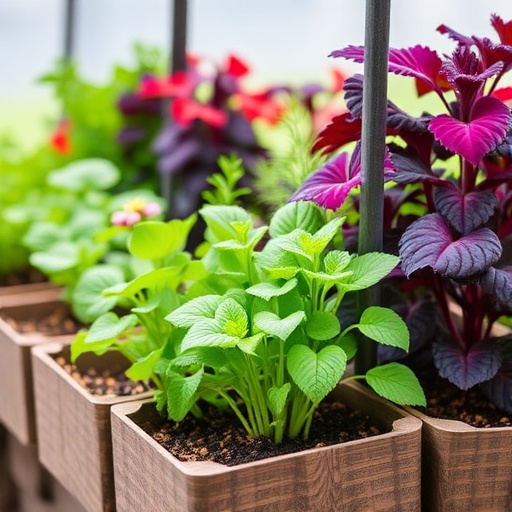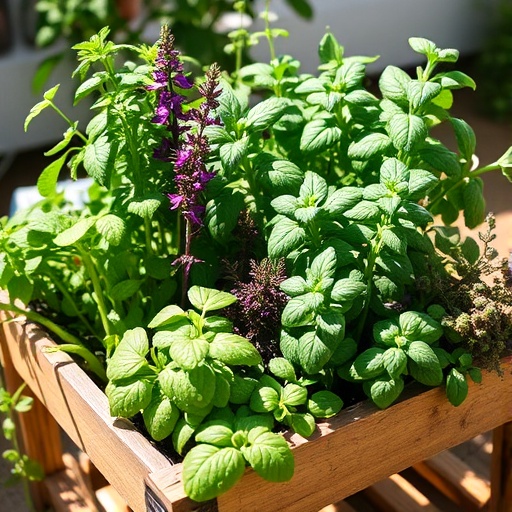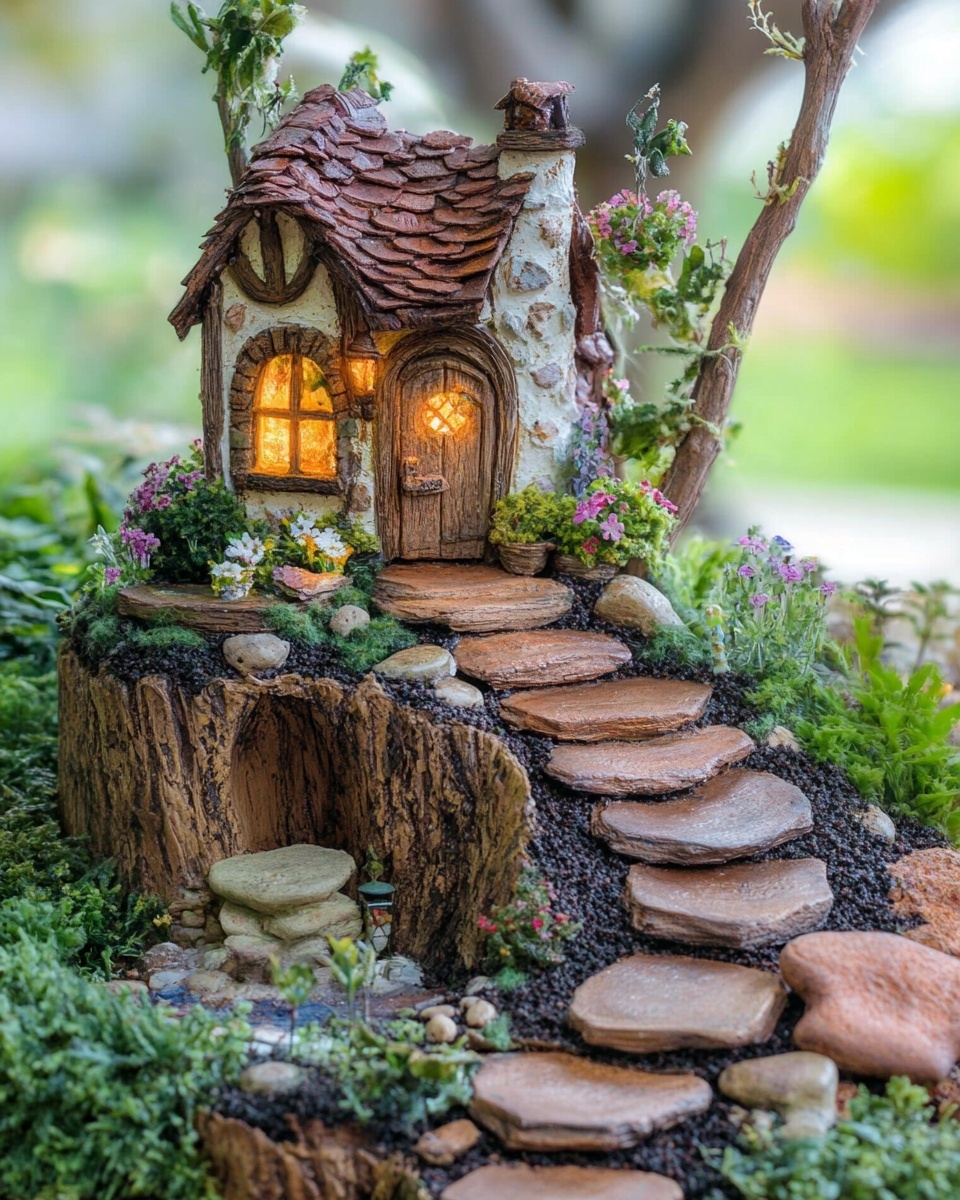Introduction
Did you know that some plants actually thrive when grown next to specific neighbors, boosting yields by as much as 20% and naturally deterring pests? Many gardeners spend countless hours battling common garden problems, from pesky insects to nutrient deficiencies, without realizing the secret might lie right beneath their noses: strategic companion planting. This ancient technique, deeply rooted in ecological wisdom, is one of the most effective organic gardening tips you can adopt to transform your garden into a self-sustaining ecosystem. By carefully selecting which herbs to grow together, you can enhance growth, improve flavor, and create a healthier, more vibrant garden without relying on synthetic chemicals. Let’s dive into how you can harness the power of nature to grow a thriving, harmonious herb garden.
Tools & Materials Needed
To embark on your companion herb gardening journey, you won't need a massive arsenal of specialized gear. The beauty of cultivating herbs lies in its simplicity and accessibility.
- Pots or Garden Beds: For containers, choose terracotta or ceramic pots with good drainage. For garden beds, raised beds offer excellent control over soil quality. If space is limited, consider a vertical planter or a window box.
- Quality Potting Mix or Garden Soil: A well-draining, nutrient-rich mix is crucial. Look for organic potting soil enriched with compost. You can also make your own by mixing equal parts compost, perlite, and coconut coir.
- Hand Trowel and Cultivator: Essential for digging small holes, transplanting, and aerating the soil gently.
- Watering Can or Hose with a Gentle Sprayer: Consistent, gentle watering is key. A watering can is perfect for pots, while a hose with a spray nozzle works well for larger beds.
- Herb Seeds or Seedlings: Start with strong, healthy plants. When choosing seeds, ensure they are non-GMO and organic for true organic gardening tips.
- Pruning Shears: Small, sharp shears are ideal for harvesting herbs and maintaining their shape.
- Gardening Gloves: Protect your hands from dirt and potential irritants.
- Labels: Essential for keeping track of your herbs, especially important if you're growing many varieties. Use reusable tags for an eco-friendly option.
Eco-friendly/Budget-friendly Alternatives: Repurpose old containers like plastic milk jugs (with drainage holes added), sturdy tin cans, or even old tires for planting. Collect rainwater for watering, and make your own compost from kitchen scraps to enrich your soil.
Time & Effort Overview
Starting a thriving herb garden with companion planting is surprisingly manageable. Initial setup, including soil preparation and planting, usually takes about 2-4 hours per 4×4 foot garden bed or 5-6 pots. Compared to growing finicky annual vegetables, herbs are typically very forgiving, growing about 30% faster in their ideal conditions.
- Planting: 1-2 hours for a small to medium-sized project.
- Daily Check-ins: 5-10 minutes for watering and observation.
- Weekly Maintenance: 30-60 minutes for light pruning, pest checks, and harvesting.
- Overall Difficulty: Beginner to Intermediate. While the initial concept of companion planting adds a layer of strategy, the individual care for most herbs is quite straightforward.
Even if you're new to gardening, these organic gardening tips are designed to be accessible and rewarding.
Step 1: Planning Your Herb Layout

Before you dig, dream! Consider which herbs you use most often in your cooking and how they interact. For example, rosemary and sage love dry, warm conditions and deter cabbage moths, while parsley and cilantro prefer slightly moister soil and attract beneficial insects. Sketch out your garden bed or pot arrangement. Think about sunlight requirements – sun-loving herbs like basil, thyme, and oregano need at least 6 hours of direct sun, while mint and parsley can tolerate partial shade. This strategic planning is a cornerstone of effective organic gardening tips.
Step 2: Preparing the Soil
Good soil is the foundation of a healthy garden. For garden beds, loosen the top 6-8 inches of soil and mix in a generous amount of organic compost (about 2-3 inches deep across the surface). This improves drainage, aeration, and nutrient content. For pots, use a high-quality organic potting mix. Ensure consistent moisture and nutrient availability. Don’t worry if your garden soil isn’t perfect right away; continuous amendment with compost will improve it over time.
Step 3: Planting Your Herbs
Carefully remove your herb seedlings from their nursery containers, gently loosening any compacted roots. Dig a hole slightly larger than the root ball. Place the plant in the hole, ensuring the top of the root ball is level with the soil surface. Backfill with soil, gently firming it around the base of the plant. If sowing seeds, follow the packet instructions for depth and spacing. Remember to maintain the recommended spacing between companion herbs to allow for good air circulation and growth. For instance, growing basil near tomatoes is a classic for good reason!
Step 4: Initial Watering and Mulching
Immediately after planting, give your herbs a thorough watering. This helps settle the soil around the roots. Once watered, consider adding a thin layer (1-2 inches) of organic mulch, such as straw or wood chips, around the base of your plants. Mulch helps retain soil moisture, suppresses weeds, and regulates soil temperature – excellent organic gardening tips for water conservation and soil health.
Step 5: Ongoing Care and Observation
Regularly check your herbs for signs of growth, stress (like wilting or yellowing leaves), or pests. Water when the top inch of soil feels dry. For most herbs, deep watering less frequently is better than shallow watering often. Prune regularly to encourage bushier growth and harvest leaves as needed. This ongoing observation will help you adapt and refine your organic gardening tips strategy. Here’s how to fix common issues: if leaves are yellowing, it could be overwatering or a nutrient deficiency; check soil moisture first.
Growth & Care Tips
Consistent care is vital for a flourishing herb garden.
- Watering Frequency: Most herbs prefer consistently moist but not waterlogged soil. Check the soil daily by sticking your finger about an inch deep. If it feels dry, it's time to water. Drought-tolerant herbs like rosemary, thyme, and oregano can handle drier conditions once established, while basil, mint, and parsley prefer more regular moisture. Overwatering causes root rot in over 60% of container herb failures, so drainage is paramount!
- Sunlight Exposure: The majority of culinary herbs thrive in full sun, meaning at least 6-8 hours of direct sunlight per day. If you live in a very hot climate, some herbs like parsley and cilantro might appreciate a little afternoon shade to prevent bolting (going to seed too quickly).
- Pruning: Regular pruning is crucial for promoting bushier growth and preventing herbs from becoming leggy. Harvest leaves from the top, pinching off stems just above a leaf node. This signals the plant to produce more side shoots. Pruning also helps delay flowering, which can alter the flavor of some herbs.
- Fertilization: With good soil rich in compost, herbs generally don't need heavy fertilization. A light application of a balanced organic liquid fertilizer once a month during the growing season can be beneficial for container-grown herbs. Over-fertilizing can lead to lush foliage but diminished flavor.
- Pest Prevention: Companion planting is your first line of defense! For instance, garlic and chives deter aphids, while mint can ward off ants. If pests do appear, use organic solutions like neem oil spray or horticultural soap. Inspect your plants regularly to catch issues early, which is a key part of organic gardening tips.
Eco-Friendly & Sustainable Alternatives
Embracing sustainable practices in your herb garden benefits both your plants and the planet.
- Composting: Start a compost bin! Kitchen scraps, yard waste, and even shredded paper can be transformed into nutrient-rich humus for your garden. This significantly reduces waste and eliminates the need for synthetic fertilizers.
- Natural Fertilizers: Beyond compost, consider using worm castings, kelp meal, or fish emulsion. These provide a slow release of nutrients without harsh chemicals.
- Water Conservation: Implement drip irrigation or soaker hoses to deliver water directly to the root zone, minimizing evaporation. Rain barrels are another excellent way to collect and store water. Group plants with similar water needs together to optimize watering schedules.
- Small Space Solutions: Not everyone has a sprawling backyard.
- Balcony Gardens: Many herbs thrive in pots on balconies. Explore options like our guide on how to start a balcony herb garden in small spaces, or discover diy hanging herb planters for balconies.
- Vertical Gardens: Utilize vertical space with wall-mounted planters or tiered garden shelves. This dramatically increases your planting area without taking up valuable floor space.
- Container Gardening: Any container with good drainage can become a home for herbs. Just ensure it's large enough for the mature plant.
Creative Ideas & Uses
Your herb garden isn't just for cooking; it's a living piece of art and a source of well-being.
- Edible Landscaping: Integrate herbs into your existing flower beds. Their varied textures and colors can add visual interest. Lavender and rosemary, for example, have beautiful blooms and evergreen foliage.
- Aesthetic Combinations: Pair herbs with complementary foliage colors. Purple basil next to variegated sage creates a stunning contrast. Taller herbs like fennel can add architectural height to your arrangements.
- Repurpose & Decorate: Use attractive pots, old wooden crates, or even vintage teacups (with drainage holes!) as planters. Create decorative labels using painted rocks or wooden stakes. You can also press dried herbs into homemade botanical art.
- Fragrance & Wellness: Plant aromatic herbs like lavender, lemon balm, and chamomile near seating areas to enjoy their soothing scents. Use them for homemade potpourri, essential oils, or relaxing teas. For more inspiration on creating beautiful plant displays, check out our Pinterest board for gardening ideas: https://www.pinterest.com/janatjanay47/.
Common Mistakes to Avoid
Even seasoned gardeners make mistakes. Being aware of these pitfalls can save you a lot of heartache and ensure your organic gardening tips pay off.
- Overwatering: This is probably the number one killer of potted herbs. As mentioned, overwatering causes root rot in 60% of houseplants and many container herbs. Always check soil moisture before watering.
- Crowding Plants: While companion planting encourages synergy, too many plants in one small spot leads to competition for nutrients, water, and light, and reduces air circulation, making plants more susceptible to fungal diseases. Give your herbs room to breathe!
- Ignoring Sunlight Needs: Placing a sun-loving herb in too much shade will result in leggy, weak growth and poor flavor. Conversely, sensitive herbs like cilantro can bolt quickly in intense, hot sun.
- Neglecting Drainage: Pots without drainage holes are a recipe for disaster. Excess water will accumulate, leading to root rot. If a pot lacks holes, drill them yourself or use it as a decorative cachepot with a well-drained inner pot.
- Harvesting Incorrectly: Continuously harvesting only the bottom leaves or allowing herbs to flower prematurely can shorten their lifespan and reduce productivity. Always pinch from the top or cut stems just above a node.
Maintenance & Storage Tips
Ensuring your herbs remain healthy and productive throughout the season and beyond requires a bit of foresight.
- Seasonal Care:
- Spring: Begin repotting or refreshing soil in garden beds. Start new seeds indoors or sow directly when the danger of frost has passed.
- Summer: Water consistently, prune regularly, and harvest frequently to encourage new growth. Watch out for pests and address them quickly.
- Fall: Harvest heavily before the first frost. Bring tender herbs (like basil or tender rosemary) indoors if you want to overwinter them. You can learn more about bringing herbs indoors in guides like how to grow herbs indoors.
- Winter: For outdoor herbs in cold climates, apply a thick layer of mulch to insulate roots. Reduce watering for indoor herbs as their growth slows.
- Long-Term Plant Health: Rotate your herbs in garden beds each year (if possible) to prevent nutrient depletion and disease buildup. Regularly amend soil with compost to maintain its vitality.
- Solutions for Common Issues:
- Yellow Leaves: Often a sign of overwatering or nutrient deficiency. Check soil moisture first. If it's dry, add a balanced organic fertilizer. Poor soil drainage can also lead to yellow leaves; improve drainage by adding perlite or sand.
- Leggy Growth: Usually caused by insufficient light. Move plants to a sunnier spot or use supplemental grow lights for indoor herbs. Pruning promotes bushier growth.
- Pest Infestations: Isolate affected plants. Use organic pest control methods like hand-picking, neem oil, or insecticidal soap. Companion planting itself significantly reduces pest pressure.
- Harvesting and Storing Herbs:
- Fresh: Most herbs are best used fresh. Store cut stems in a glass of water on the counter or in the refrigerator, covered loosely with a plastic bag.
- Drying: Tie bundles of herbs and hang them upside down in a warm, dark, well-ventilated area. Alternatively, use a food dehydrator or a low oven setting. Store dried herbs in airtight containers away from light and heat.
- Freezing: Chop herbs and freeze them with a little water or olive oil in ice cube trays. Once solid, transfer to freezer bags. This preserves their flavor remarkably well.
Conclusion
Embracing the wisdom of companion planting is not just an effective gardening strategy; it's a step towards more sustainable and joyful plant cultivation. By following these organic gardening tips, you're not just growing herbs; you're nurturing a resilient ecosystem where plants support each other, naturally improving vigor, deterring pests, and enhancing overall garden health. The satisfaction of harvesting vibrant, aromatic herbs that have thrived through natural synergy is unmatched.
Ready to transform your green space? Don't wait! Start planning your companion herb garden today, even if it's just a few pots on a windowsill. Share your progress and photos with us; we'd love to see your living masterpieces. Which herbs are you excited to pair first?
FAQ
Q1: What are the best companion herbs to grow together for pest control?
A1: Several herbs are excellent natural pest deterrents. For example, rosemary and sage repel cabbage moths and bean beetles. Mint can deter ants and rodents. Borage is known to attract beneficial pollinators and predators of common garden pests, making it a fantastic companion for a wide range of plants, including tomatoes. These simple organic gardening tips can greatly reduce reliance on pesticides.
Q2: Can I grow all herbs in pots, and do companion planting principles still apply?
A2: Yes, most herbs adapt very well to container gardening. Companion planting principles absolutely apply! Just ensure your pots are large enough for the mature size of your chosen herbs and have excellent drainage. For instance, growing basil and tomatoes in a large shared container works wonderfully, enhancing the flavor of both.
Q3: How do I know if my herbs are getting enough sunlight?
A3: Most culinary herbs require at least 6-8 hours of direct sunlight daily to thrive. If your herbs are growing tall and leggy with sparse leaves, or if their flavor seems weak, they are likely not getting enough light. Try moving them to a sunnier spot or supplementing with a grow light if growing indoors.
Q4: What's the best soil mix for companion herb gardens?
A4: For both garden beds and pots, a well-draining, nutrient-rich soil mix is crucial. For beds, amend existing soil with plenty of organic compost. For containers, use a high-quality organic potting mix, often a blend of compost, peat moss (or coconut coir), and perlite for drainage. This foundation is key for healthy herb growth and embodies best organic gardening tips.
Q5: How often should I fertilize my companion herbs?
A5: Herbs generally don't need heavy fertilization. If you've started with nutrient-rich soil or added compost, they might not need any additional feeding, especially in garden beds. For container-grown herbs, a light feeding with a balanced organic liquid fertilizer (like fish emulsion or seaweed extract) once every 4-6 weeks during the active growing season is usually sufficient. Over-fertilizing can negatively impact flavor.
Q6: Are there any herbs that should not be grown together?
A6: Yes, just as some herbs are good companions, others can hinder each other's growth. For instance, fennel is known to inhibit the growth of many plants, so it's generally best grown on its own. While mint is a wonderful companion for many plants, its aggressive spreading habit means it's best grown in its own container to prevent it from suffocating other herbs.
Continue Your Gardening Journey with Pincraft Pro:
- Looking for more ways to optimize your growing space? Dive into our guide on how to design a productive greenhouse layout.
- Explore new possibilities with your herbs by checking out our tips on easy indoor gardening setup for beginners.
- For those with limited space, discover creative vertical indoor garden ideas for small spaces.
- Learn how to keep your potted friends healthy, even when you're away, with our advice on how to water balcony herbs without overwatering.
- Thinking about moving your established indoor herbs outside? This guide on how to grow herbs indoors move them to balcony has all the information you need!






